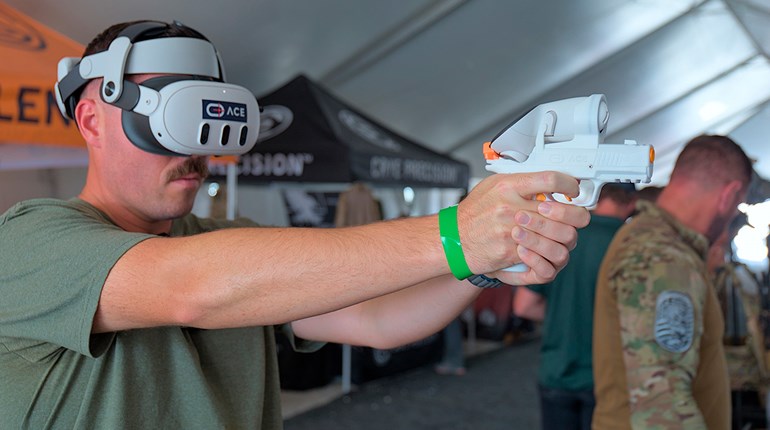
NRA Certified Firearms Instructors take great pride and satisfaction in educating others in the safe and proper use of firearms, but occasionally they encounter students who believe they don’t have anything new to learn. In fact, from what I’ve experienced in my many years of training, there are five types of know-it-all students of whom firearm trainers need to be aware. Have you encountered these students—or are you one?
I Do Not Need This Class
The “I do not need this class" student is annoyed that they must attend a basic firearms class. This student makes the others know that he does not need this class. He does this by sharing his extensive gun knowledge, declaring he has been shooting since he was 2 years old, brags about how he was a trained sniper, or announces any other bold statement to let everyone in the class think that a basic class is beneath him. He then follows up with the reason why he is actually in the class, i.e., to obtain the NRA Instructor rating; because it is a prerequisite to teach his state’s Concealed Carry Instructor course; it is a requirement to join a local gun club; or even required for his job.
Fortunately, although this student may be stubborn at the beginning of class, he quickly calms down as he begins to understand the importance of taking an NRA Basic Firearms Course. The “I do not need this class” student is easy to deal with as long as the instructor does his or her job correctly, usually after explaining why the NRA requires everyone to take the Basic Course before becoming an instructor—which is to ensure standardization of the basic curriculum, so all instructors are consistent in their teachings.
Stump the Instructor
The “stump the instructor” student can be very distracting if not addressed immediately. This student usually attends your class with others he or she knows—their spouse, friends, or business partners. This disrupting student tries to come up with questions that relate to the topic at hand, but usually have no relevance in a basic class. In other words this student might ask questions regarding advanced shooting techniques or technical questions that are not covered in an introductory firearms class.
The “stump the instructor” student is not hard to deal with. When he or she asks the first question that does not apply to a basic class, always thank them for the great question and then remind him or her that this is a basic class and that is not part of the NRA Basic curriculum. You can then follow up and say that you do not want to confuse the basic students in the class by introducing advanced firearms information, and that you can discuss it further on a break if they wish. The “stump the instructor” student gets the message very quickly that you are not going to play that game and take the bait.
The last thing you want to do is let the “stump” student win and take over your class. Do not give him or her the satisfaction of making you admit in front of your class that you do not know the answer to their questions. This might lead to you losing some credibility with your other students. If you do let this type of student succeed in their tactics, then be ready because he or she will not let up and will continue asking more questions to keep on stumping you. If he or she continues to be a distraction, you as the instructor will have to take a break and visit with this student, asking him or her to stop asking questions that are not suited for a basic class.
Look How Smart I Am
The “look how smart I am” student’s goal is to impress the classmates he or she doesn’t know, which is different than “stump” student, who wants to impress the others in class that he or she does know. The ironic part of the “look how smart I am” student is that they usually turn out not to be very smart at all. These students almost always fall under the category of being a “legend in their own minds!”
The “look how smart I am” student often holds impressive “degrees” and acknowledges credibility in watching firearm training videos. They usually have a bachelor’s degree from X (formally Twitter) and a master’s degree from YouTube. The “advanced” students hold a PhD from videos they’ve studied on TikTok! This student will come up with some of the most interesting questions. Whereas the two types, the “I do not need this class” and the “stump the instructor” students try to make you the instructor look bad, the “look how smart I am” student’s goal is to only to make themselves look smart.
The “look how smart I am” student is harmless to your credibility and easy to deal with. I always caution them about liability when it comes to instructing off videos they have watched. I let them know that if something goes wrong and someone gets hurt, they have nothing to back up the training they are conducting. I tell them it is always advisable to teach from a written and proven curriculum such as the NRA Firearm Training in the specific discipline.
As an instructor, it is important to remember to value other students’ opinions as long as that student is not giving bad information regarding safety or describing improper shooting techniques. A good firearms instructor always gains knowledge by listening to his or her students.
The “Hijacker”
The “hijacker” student tries to take over the class—but usually not intentionally. They either have lots of stories or are already extremely knowledgeable about the subject. This type of student can be fun to have in class, if managed properly. These students are usually very involved following the NRA’s Total Participant Involvement (TPI). Boy Scout Leaders, firearm armorers and gunsmiths oftentimes fall into this category of students.
These students are great to have in class because they can enhance a topic of discussion if you choose to call upon their expertise. This type of student is easy to deal with if he or she is starting to become a distraction. Normally, all it takes is to talk to them on a break and explain that we are spending too much time on stories. A quick informal counseling session usually solves the problem and does not hurt anyone’s feelings.
The “Contrary” Student
The “contrary student” gets the award for being a real pain in the “class!” These students argue about everything. This student always has a better way of doing anything and everything the instructor is teaching. They have accomplished whatever the topic is better, faster, and more effective. This student, in his or her mind, has done everything, been everywhere, and won every shooting award.
This type of student can be difficult to handle, especially during an NRA training course, during which he must be reminded that when conducting an NRA course, the lesson plan must be followed. If the “contrary” student continues to be a disruption in the classroom or if you, as an instructor, feel this student does not have the right attitude, he or she should be counseled or ultimately, be removed from the class without completion or certification. This is especially true if you believe that this student is not going to teach an NRA course according to the required lesson plan.
It does not matter which type of student you may have in your NRA Firearms Training class, it is up to you, the instructor, to handle the situation before it affects the other students. The NRA provides its instructors the tools and training to deal with students that cause distractions.
A student can complete all the objectives and pass the classroom portion, the live fire portion, and the exam and still flunk because of his or her attitude. The first thing an instructor needs to do if more passive ways to reel in a student who is causing distractions fails, is to have a counseling session with them. In the session, the instructor must tell the student what type of behavior is expected in the classroom and then explain how they are causing a distraction. If that fails, the instructors only option is to remove them from the class by asking them to leave. Always remember to document in your records if a student is dismissed from the class.
Always remember that the other students in attendance are not getting the experience and class they paid for if someone is being disruptive. As an instructor, you need to take charge and maintain control of your class. I explain to my instructor candidates to think back to when they were in school. We all had great teachers that we remember, and we also had bad teachers that we remember. Same goes for firearm instructors. There are great ones and bad ones. We always want to strive to be one of the great ones that students will remember, and a lot of it involves how we interact with and handle all the personality types who attend our classes.














































